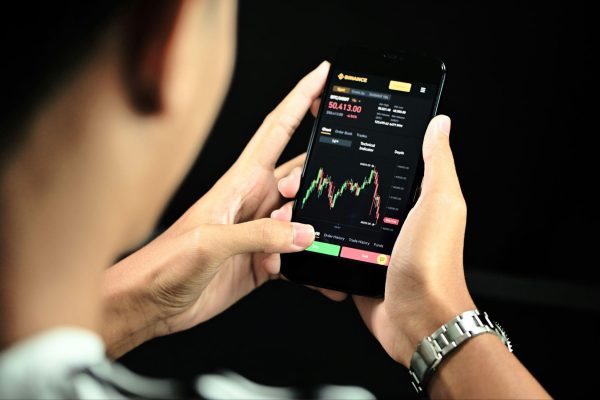The foreign exchange market, or forex (FX), is where currencies are traded. Simply put, it’s the global marketplace for exchanging one currency for another. If you’ve ever traveled abroad and swapped your dollars for euros or yen, you’ve taken part in the forex market on a small scale. For a new trader, forex might seem complex, but understanding the basics is easier than it looks.
Analyzing price charts and economic data is a key part of forex trading. The forex market operates 24 hours a day during the work week and is by far the largest financial market in the world. Trillions of dollars’ worth of currencies change hands every day – about $7.5 trillion per day globally as of 2022 – making it extremely liquid. But what exactly are traders doing in this market? Let’s start with the basics.
What Is the Forex Market?

The forex market (short for foreign exchange market) is a global decentralized market where national currencies are bought and sold. Unlike the stock market, there’s no central exchange – trading happens electronically over-the-counter through a network of banks, brokers, and financial institutions. This market determines the exchange rates we see every day. For example, when you see that 1 USD = 0.90 EUR, that rate is a result of activity in the forex market.
Key characteristics of the forex market include:
- Currencies traded in pairs: You always trade one currency for another. A pair is quoted like EUR/USD = 1.10, meaning 1 euro is worth 1.10 US dollars. The first currency is the “base” and the second is the “quote” currency. The price tells you how much of the quote currency equals one unit of the base currency.
- Global and decentralized: There is no single location or exchange for forex. It’s a worldwide network operating 24 hours a day, 5 days a week (closing only on weekends). When the trading day ends in New York, it’s starting in Tokyo and Sydney – so trading is continuous.
- Largest market by volume: Forex is the most traded financial market on the planetinvestopedia.com. High volume means high liquidity – you can usually buy or sell a currency without delay. This is one reason forex trading appeals to many; you can enter and exit positions quickly.
- Wide range of participants: It’s not just individual traders. Banks, corporations, hedge funds, and central banks all participate. Central banks might trade to stabilize their currency’s value, while companies might exchange currency for international business operations. As a retail trader (individual), you’re a small fish among giants, but technology via online brokers lets you participate with ease.
How Does Forex Trading Work?
Forex trading is the act of exchanging one currency for another in the hopes that the price will change in your favor. Unlike exchanging money at a kiosk for a trip, forex trading is done for profit and looks more like online stock trading, but for currencies. Here’s an example: you think the euro will strengthen against the U.S. dollar. You would buy the EUR/USD pair – essentially buying euros with dollars. If the exchange rate rises (meaning euros become more valuable relative to dollars), you can sell back the euros for a profit. Conversely, if the euro falls, you’d have a loss.
A few concepts are important for new traders to grasp:
- Currency Pairs: All forex trades involve a pair. Common major pairs include EUR/USD, GBP/USD (British pound vs. U.S. dollar), USD/JPY (U.S. dollar vs. Japanese yen), etc. The forex quote shows how much of the second currency equals one unit of the first. When that number moves, one currency is gaining value and the other losing relative to each other.
- Bid and Ask: For each pair, there’s a bid price (what traders are willing to pay for the base currency) and an ask price (what sellers want for it). The difference is called the spread, which is often how brokers make money.
- Leverage: Forex brokers often allow trading on leverage, meaning you can control a large position with a relatively small amount of money (margin). For instance, with 50:1 leverage, a $100 deposit lets you trade $5,000 worth of currency. Be careful – while leverage can amplify profits, it equally amplifies losses.
- Price Movements: Currency prices are influenced by supply and demand and react to economic news, interest rate changes, political events, and market sentiment. Most price changes are measured in pips, which are tiny fractions of a currency’s value (often 0.0001 for U.S. dollar pairs). Traders try to predict these movements through technical or fundamental analysis.
Modern technology has made forex trading accessible – you can trade on a smartphone or laptop from anywhere. When you place a trade, you typically do so via an online broker or trading platform. As a beginner, you’ll use a retail forex broker that provides a trading app or software. You don’t need to physically exchange stacks of cash; everything is handled digitally through your account. You’ll see real-time prices, charts, and can execute trades with a click. Your broker connects you to the larger forex market and executes orders on your behalf.
Why the Forex Market Matters (and Why Trade Forex)
Why should a new trader care about forex? Well, the forex market plays a huge role in the global economy and offers unique advantages to traders:
- Global Economic Importance: Forex is how money moves between countries. Businesses use it to convert payments from overseas sales, investors use it to speculate or hedge international investments, and travelers rely on it to get local currency. Without forex, global trade and travel would be much harder
- Liquidity and 24/5 Access: The immense trading volume (trillions per day) means you can usually buy/sell immediately – there’s always someone on the other side of the trade. Plus, the market’s round-the-clock schedule means you can trade at almost any time that suits you, whether it’s morning or midnight. This flexibility is great if you have a day job or live in a different time zone.
- Low Barrier to Entry: Unlike some markets that might require a large investment, forex trading can be started with relatively small capital. In fact, Forbes notes that you can begin forex trading with as little as $50 or even $100 depending on the broker.
- Opportunity to Profit from Currency Moves: Currency values are constantly shifting. Forex gives you an opportunity to profit from these movements – whether a currency is rising or falling, there’s potential to trade and make a gain (by going “long” or “short”).
- Diversification and Hedging: Forex can also be a way to diversify an investment portfolio. It’s a separate asset class from stocks or bonds, so some people trade currencies to spread risk or hedge other investments.
Of course, it’s important to acknowledge that forex trading carries risk. Currencies can be volatile, and using leverage adds risk of larger losses. The market can also be influenced by unexpected events (like sudden geopolitical changes). As a new trader, never risk money you can’t afford to lose, and take time to educate yourself (as we’ll cover next).
How to Get Started with Forex Trading

Ready to dip your toes into currency trading? Here’s a step-by-step roadmap for beginners to start forex trading:
- Learn the Basics: Take time to learn key concepts – how currency pairs work, what affects exchange rates, and basic trading strategies. There are plenty of free resources to build your knowledge, including articles, tutorials, and videos. For example, markets4you.com offers beginner-friendly guides and glossaries for new traders. You can also check out Markets4you’s educational article on understanding the global currency market to strengthen your foundation on what forex is and how it operates.
- Choose a Reputable Broker: A forex broker is your gateway to the market. Look for a well-established broker that is regulated by financial authorities in your region.
- Practice with a Demo Account: Most brokers provide a demo account – a simulated trading account with fake money. This is an invaluable tool for beginners. Use it to practice placing trades, familiarize yourself with the trading platform interface, and test out strategies without risking real cash.
- Start Small with Real Trading: When you go live, start with a small amount of money. Thanks to low minimum deposits, you could begin with even $100 or $500. Use small trade sizes (many brokers let you trade micro lots of 1,000 units or even less) so that any losses are minimal as you learn.
- Have a Basic Strategy and Risk Management Plan: Before you trade, have at least a simple plan. More importantly, always use risk management tools like stop-loss orders (which automatically close a trade at a predetermined loss to prevent deep losses).
By following these steps, you build a strong foundation and gradually ease into trading. It’s tempting to jump straight in, but patience and preparation pay off in the long run.
Final Thoughts
Forex trading can be an exciting venture for young and new traders. You get to engage with a truly global market and learn about how economies interact, all while having the flexibility to trade from your phone or computer at your convenience. The forex market matters because it affects everything from the price of imported goods to the value of your vacation money, and for traders it offers a chance to profit from these currency movements.
As a beginner, the key is to approach forex with a mix of enthusiasm and caution. Start by mastering the basics and make use of the abundant free resources available. Practice diligently, manage your risks, and don’t be afraid to start small. With time, what once seemed confusing will become second nature. Forex is a journey – one that can be professionally rewarding and intellectually enriching. Good luck, and happy trading!













